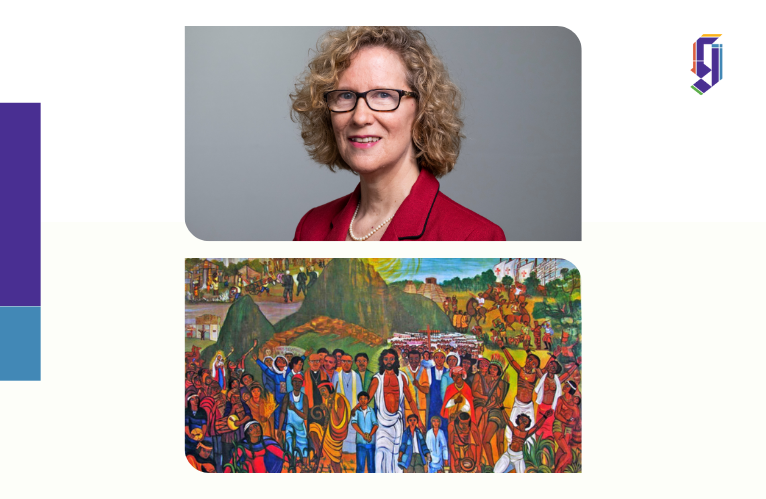We Follow an Embodied Christ
October 9, 2024
An Interview with Dr. Nancy Bedford

“There is no abstract Christ.” As I talk with Dr. Nancy Bedford, Georgia Harkness Professor of Theology, about her new work on Christology, a resolute conviction fills her eyes. Her forthcoming book, Jesús: Una Cristología al Andar, to be published in Spanish, intended primarily for a Latin American readership—grounds itself firmly in the gospels, resisting the rise of theologies that seek to divorce the concrete way of Jesus from the Christian faith. “Recently this year, I have personally encountered pastors in Latin America and the U.S. who don’t want to talk about Jesus’ life,” she says. “They want to talk about the cross, about an abstract Christology that lets us do our own thing, instead of discussing the way of Jesus.’”
This distinction is not just philosophical, it carries profound political implications. “Docetism is a huge problem. A ghostly Jesus goes against both our own bodies and the incarnation—it rejects the fact that Mary was a brown woman, that the guarantor of Jesus’ full humanity also embodies a non-whiteness,” Dr. Bedford explains. “If you search ‘Jesus’ on Google, you get all these pictures of a white, ghostly Jesus. I understand that every community can depict Jesus in their own ways, but we must look at the power dynamic of that particular image and why it pushes out all other images of Christ.” Resurfacing different depictions is an essential part of this new project. Moving through his own life stages, it illuminates Jesus the Child, Teacher, Brother, and Friend.
Throughout, Dr. Bedford often turns to Central and South American art and poetry to better understand these facets of Jesus’ identity. “I’m so interested in colonial art from Latin America, where indigenous painters and sculptors learned European techniques, but also wove in their own cultural elements,” she notes. “For example, in Mexico the hummingbird was a divine symbol, so many paintings use the hummingbird to represent the Holy Spirit instead of a dove. Or in Peru and Bolivia, you get fascinating depictions of Mary the mother of God as a kind of mountain—a triangular portrayal connected to the Earth and Pachamama.” This interplay between art and culture invites us to reconsider Jesus’ own cultural particularities.
“There’s a clear connection between the particularity of Christ and the universality of Christ’s message,” Dr. Bedford elaborates. “Jesus lived in a particular time and place—young, Jewish, a handyman, male coded. It’s not that those particularities are superior to any other particularity, but a reminder that all of our particularities are a gift, all made in the image of God, and are represented in his particularity.” The problem is not that Christ has ever been depicted as someone with blond hair and blue eyes. Rather, it’s that this interpretation of the gospel has become so ubiquitous that it pushes aside both the realities of Jesus’ own life and all the other ways that the universality of the gospel finds particular expression. Latin American art and theology provide a fruitful corrective.
From stations of the cross in El Salvador that blend details from Jesus’ life and imagery from the Salvadoran Civil War to depictions of the holy family as migrants crossing the border, communities have used art to tether Jesus’ life and their own. “It’s not so much that people identify with Christ because he’s suffering and they’ve been suffering, and so become sufferers who accept suffering passively,” Dr. Bedford explains. “Often there’s a subversion of the logic of suffering that happens in loving and identifying with Jesus. It’s a fascinating reciprocal dynamic: God has compassion for us, but we can also have compassion for God in Christ.” These works’ theological power arises from faith not rooted in an abstract notion of a God, but in specific gospel details.
Dr. Bedford’s book also comes amid a disturbing trend by Christian Nationalists to vilify migrants and Latin America. “It’s pre-genocidal discourse to talk about people as bugs and insects, as vermin to be destroyed,” she notes. “There’s a forgetfulness of what this country is doing to generate this flow of people.” Decades of U.S. military support for dictators and participation in antidemocratic coups, extractive economic policies, the widespread proliferation of U.S.-manufactured guns—all these U.S. sins are mendaciously obscured to characterize Latiné communities as inherently violent. This rejection of specific details in favor of sweeping narratives is mirrored in Christian Nationalist Christology. “They seek to empty the gospel from its context to create an abstract, quiet Jesus, who is also a capitalist,” Dr. Bedford says. “If you do that, the Christian religion becomes just one more ideology that can be used to manipulate people.”
The antidote to this religious poison lies in restoring Jesus’ full humanity without denying his divinity. “Christology itself has the power to critique a hurtful Christology,” Dr. Bedford suggests. “Grounded in the actual life of Jesus of Nazareth, we must say that his incarnation, life, death and resurrection cannot be reduced a transaction on the cross—that to understand the good news of the gospel we need to pay attention to Jesus’ teaching, his parables, his walking along the ground.” In addition to providing a corrective to Christology that hollows out the Christian faith, these beliefs hold transformative power. “It’s what precedes the resurrection and gives hope for resurrection, pushing back against dominant forms of doing things,” she says. “Following Jesus in these concrete ways not only sustains you in the face of troubles, it lets you imagine another possibility, another hope.”

